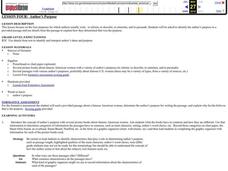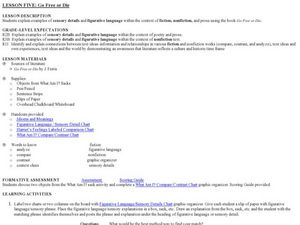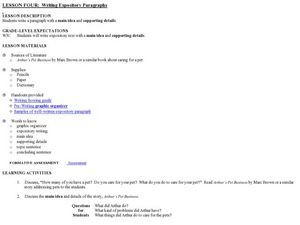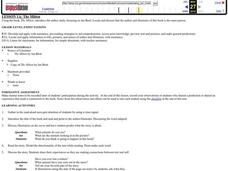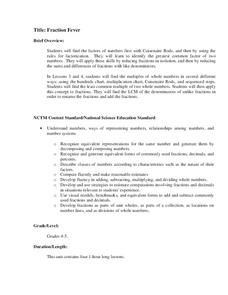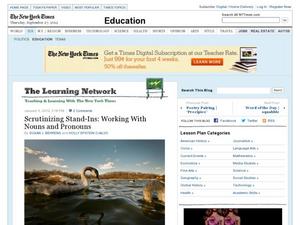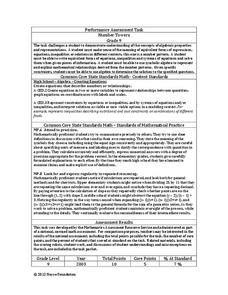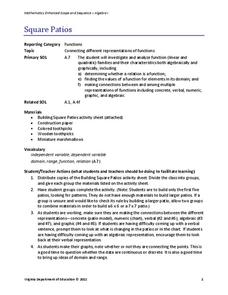Curated OER
Author's Purpose
Readers identify the author's purpose. First, they read a passage and utilize details from the piece to determine the author's purpose. Then they will explain how they arrived at their conclusion. Links to materials are provided.
Curated OER
Non-Fiction Text Features
Distinguish between textual features of non-fiction in the book The Lewis and Clark Expedition and in the non-fiction story "Ta-Na-e-Ka." Third graders create posters and participate in group discussions to show their...
Curated OER
Go Free or Die: Figurative Language
Figures of speech, sensory details, and academic language are all targeted while reading Chapter Two of J. Ferris’ Go Free or Die. First, learners engage in an exercise to practice describing with detail. Then, partners use a...
Curated OER
Locate Key Information in Nonfiction Text
Interpret nonfiction text with your class. Readers use key information found in nonfiction text to answer questions and problem solve. They utilize the chapter headings, diagrams, glossary, maps, and captions as well as the table of...
Curated OER
Writing Expository Paragraphs
Learners read Arthur's Pet Business and complete a pre-writing worksheet for expository writing. In this paragraph writing lesson, students gather and organize material for a paragraph about pets.
Curated OER
Cloudy With a Chance of Meatballs-Part I
Here is a lesson plan that gives learners a chance to practice using context clues. They read the story, Cloudy with a Chance of Meatballs. Learners use different word strategies (base words, synonyms, antonyms) to decode and understand...
Curated OER
Writing a Friendly Letter
Elementary schoolers write a friendly letter. In this letter writing lesson interrogative and declarative sentences in their friendly letter. The young scholars write to an intended audience.
Curated OER
Inferring Vocabulary Meaning
Explore the meaning of unknown words! Read All I See with your class, having them complete the inference chart provided while reading. They select unknown words, guess their meanings, and identify what other words or pictures helped them...
Curated OER
The Mitten
Explore children's literature by researching a book and it's author. Youngsters read the story The Mitten by Jan Brett and discuss the animals and characters mentioned in the story. Then, they practice retelling their favorite portion of...
Curated OER
Where are the Mittens?
Help early readers identify rhyming words in nursery rhymes. They will read the nursery rhyme Three Little Kittens Who Lost Their Mittens in order to identify rhyming words. Then they chart the rhyming words they heard in the...
National Security Agency
Fraction Fever
This unit on fractions allows for upper-aged elementary learners to explore ways to find the greatest common factor and least common multiple of two numbers. Ultimately, young mathematicians will be able to identify equivalent fractions,...
Curated OER
Scrutinizing Stand-Ins: Working With Nouns and Pronouns
Use the Schoolhouse Rock episode, "Rufus Xavier Sarsaparilla," to introduce a study of pronouns. Learners consider antecedents, cases (nominative, objective and possessive), as well as types of pronouns, and then craft sentences using...
University of Wisconsin
Conjunction Function
As part of a unit, this lesson familiarizes youngsters with components of a rain garden. They speculate about the role of an assigned component in contributing to a rain garden, and ultimately, in the health of the local watershed. Each...
Odyssey of the Mind
Odyssey of the Mind Curriculum Activity: From a Distance
Challenge your class with an amazing set of ideas that really put the project back into project-based learning. It all starts with a whole class research task. Each learner will look up and take notes on multiple facets of things that...
Urban Education Exchange
Lessons and Units: The Watsons go to Birmingham—1963 5TH GRADE UNIT
Get ready to read The Watsons Go to Birmingham - 1963 with a lesson about historical fiction. Spanning several centuries, the resource prompts learners to guess the historical era of a story based on a word or phrase...
Novelinks
Wildwood Dancing: Vocabulary Squares
As part of a study of Juliet Marillier's Wildwood Dancing, class members create vocabulary squares for words drawn from the story.
Laboratory for Atmospheric and Space Physics
Planetary Distances on the Playground
There's no need to stay inside; get out of the classroom and create a scaled map of the solar system on your playground field! In collaborative groups, scholars identify the distance between the sun and other planets, place planet...
Odell Education
Plant and Animal Cells
Incorporate multiple facets of the cell into your next high school lab! Through an introduction to cell organelles, class members observe each cell type and draw visuals to further demonstrate understanding of cellular processes in both...
Noyce Foundation
Truffles
Knowing how to scale a recipe is an important skill. Young mathematicians determine the amount of ingredients they need to make a certain number of truffles when given a recipe. They determine a relationship between ingredients given a...
Inside Mathematics
Number Towers
Number towers use addition or multiplication to ensure each level is equal. While this is common in factoring, it is often not used with algebraic equations. Solving these six questions relies on problem solving skills and being able to...
Inside Mathematics
Squares and Circles
It's all about lines when going around. Pupils graph the relationship between the length of a side of a square and its perimeter. Class members explain the origin in context of the side length and perimeter. They compare the graph to the...
University of Colorado
Spacecraft Speed
Space shuttles traveled around Earth at a speed of 17,500 miles per hour, way faster than trains, planes, or automobiles travel! In the 13th installment of 22, groups graph different speeds to show how quickly spacecraft move through...
Virginia Department of Education
Square Patios
Build a patio from toothpicks and marshmallows to analyze functions! Learners look for patterns in the data as they create different size patios. As they discover patterns, they make connections between the different representations of...
Childnet International
Cyberbullying Drama
Target, bystander, or bully? Class groups watch a short student-produced video about cyberbullying and then devise and script their own drama to encourage discussion about this hot button topic.
